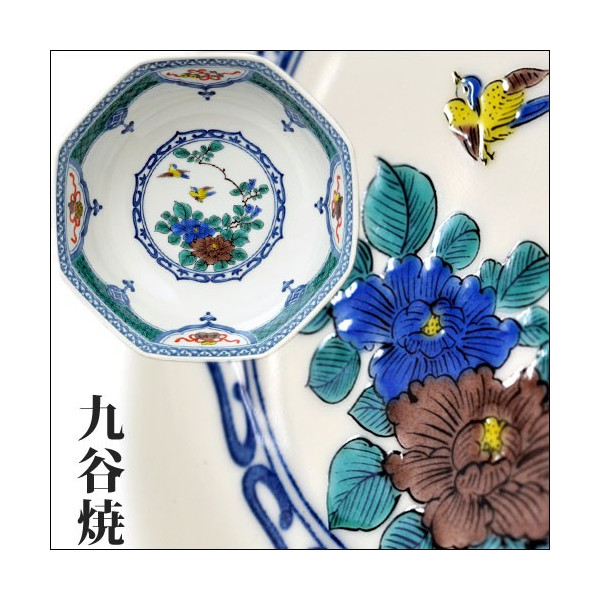Kutani ware is one of the most well known ceramic wares in Japan which have been captivating art lovers for more than 360 years. It is also one of the most popular souvenir items when you travel to Kanawaza. This feature shows you what Kutani ware is and some of the easily available items on the market to get the feel of time-honored Japanese ceramic ware.
Table of Contents
Kutani Ware History
Kokutani (Old Kutani)
Historical records say that Kutani ware was originally established in mid-17th century when the lord of Kaga Domain close to Kanazawa dispatched the ceramic artisan Goto Saijiro to Arita ware producing area to learn the technique so that they can create their own ware using the excellent clay material found in the Kutani area. Despite the great success of Kokutani filled with a host of legends and acclaims the production of Kokutani discontinued by the mid-18th century.
Saiko Kutani
It was the merchant of Kaga district, Yoshidaya Den’emon, who re-established the ware by creating the climbing kiln right beside the Kokutani kiln site in Kutani area in 1823. Re-established Kutani ware (Saiko-kutani) started the production next year.
Japanese Kutani
In 1873 Vienna International Exposition, Kutani ware was introduced to the world as “Japanese Kutani” and its winning recognition led to the export of Japanese Kutani.
Today Kutani ware is one of the most popular souvenir items in Kanazawa and its nearby areas.
Kutani Features and Traditional Techniques
Kutani ware is actually the collective name for earthenware both pottery and porcelain produced in Kutani area with unique coating method Uwaenuri.
Using five colors, red, yellow, green, purple and Prussian blue, Kutani ware shows wide variety of aesthetic beauties of nature and landscapes.
Traditional Techniques
After finishing material preparation, forming/shaping, drying processes, and bisque firing, underglaze decoration process begins.
In this process, five major pigments to denote colors, red, yellow, green, purple and Prussian blue are added, though some of which do not look like finished color after glazing. Coloring of Kutani ware have been done so excellently it is one of the unmistakable feature of this ceramic ware.
Major Styles
Old Kutani
The style emulating the old Kutani days style featuring the exquisite use of five basic colors. The motifs of the painting are often based upon Chinese style landscape or portrait paintings.
Yoshidaya Style
The style is based on the works from the re-established kutani kilns in early 19th century. This style incorporates with rectangle patterns in blue, yellow and purple. Compared with Kokutani painting touches became milder.
Iidaya Style
The style established around 1830 to 1845 by Iida Hachiroemon themed with ancient Chinese literature and poetry.
Kutani Ware for Sale
1. Good-Luck Cat, Kimori
Manekineko is one of the most popular good-luck charms in Japan also known as good-luck cat (beckoning cat). Although outstanding majority of these ceramic cat figurines on the market are either from Tokoname, or Seto, those of Kutani ware are vividly designed and possess distinctive feel. Like manekineko from other producing areas, Kutani cats come with various colors (white, black, yellow and red) and styles. This yellow one is said to bring you wealth because the color yellow denotes gold and is symbolic of wealth.
Kimori #3 and #5 are some of the most easily available Kutani products on the market. #5 is the bigger of the two.
2. Amabro Moomin Japan Kutani Gosai Set
Modern Kutani ware plates have a number of non-Japanese, non-Chinese motifs such as Snoopy beagle from Peanuts and Tove Jansson’s Moomin series characters as this one. This five-piece small plate set incorporates major moomin characters into five typical Kutani ware color decoration patterns. All five plates are about 130 mm in diameter and its box size is W170 × H385 × D60 mm.
3. Kutani Coffee Cup and Saucer “Ginsai”
Ginsai is one of the major traditional Kutani ware techniques putting the layer of transparent and coloring glazes of five basic kutani colors over silver leaf to withstand heat. These cups are made with complicated processes because it requires one more heating process compared with regular production method. Finished products show moderate brightness and gentle radiance with glass-like feel.
After Word
If you love Japanese Kutani items, I am sure you will love to visit Kanazawa and its surrounding areas where this amazing ceramic ware originated. Kanazawa is only two and a half away from Tokyo using Hokuriku Shinkansen. You will definitely find a host of amazing things there.





